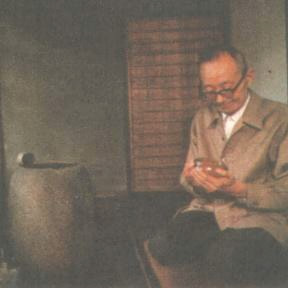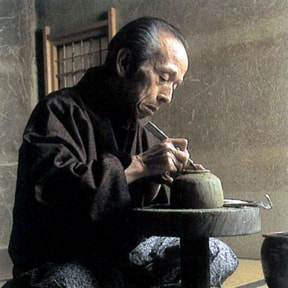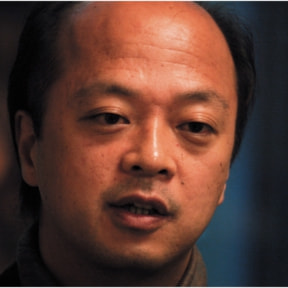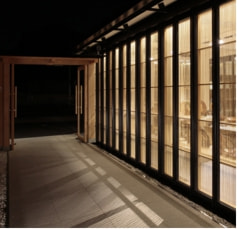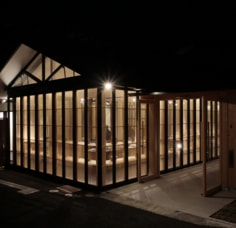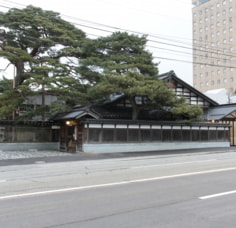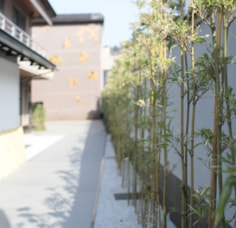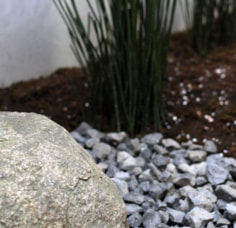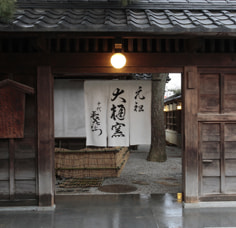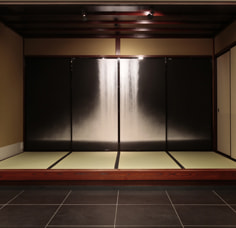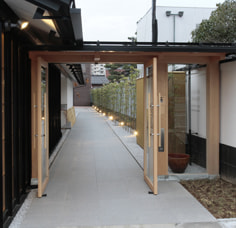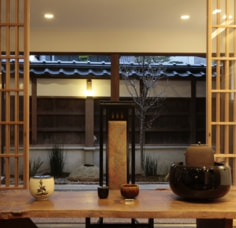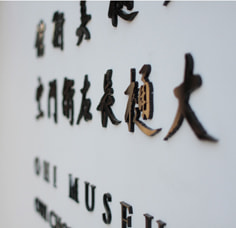
初代 大樋 長左衛門(芳土庵) 1631〜1712
1st Ohi Chozaemon (Hodoan)
ニ代 大樋 長左衛門(芳土庵) 1686〜1747
2nd Ohi Chozaemon (Hodoan)
三代 大樋 長左衛門(勘兵衛・芳土庵) 1728〜1802
3rd Ohi Chozaemon (Kanbei・Hodoan)
四代 大樋 長左衛門(勘兵衛・土庵) 1758〜1839
4th Ohi Chozaemon (Doan,Kanbei)
五代 大樋 長左衛門(勘兵衛・土庵) 1799〜1856
5th Ohi Chozaemon
六代 大樋 長左衛門(朔太郎) 1829〜1856
6th Ohi Chozaemon
七代 大樋 長左衛門(道忠) 1834〜1894
7th Ohi Chozaemon
八代 大樋 長左衛門(宗春・松涛・以玄斉) 1851〜1927
8th Ohi Chozaemon
九代 大樋 長左衛門(陶土斎) 1901〜1986
9th Ohi Chozaemon
十代 大樋 長左衛門(陶冶斎) 1927〜2023
10th Ohi Chozaemon(Toyasai)
十一代 大樋 長左衛門(年雄) 1958〜
11th Ohi Chozaemon(Toshio)
奈良 祐希 1989〜
Nara Yuki

When the founder of the Urasenke tradition of tea ceremony, Senso Soshitsu (1622 - 1697) was invited to Kanazawa as the lord of the tea ceremony for the Kaga Clan in 1666, the first Chozaemon came with him and established Ohiyaki Ware in Kanazawa. At that time, Senso Soshitsu was 45 years old and Chozaemon was 37. Chozaemon had been the chief apprentice for the Raku family in Kyoto and took with him to Kanazawa many of the principles and ideas associated with Rakuyaki Ware. He made tea utensils taking the advice of Senso and began producing wares using the local clay at Ohi Village. The name Ohiyaki originated from the name of this village and was located just outside of Kanazawa. The Ohi Amber Glaze, which is a trademark of the work, was presented to Chozaemon from the Raku family to use exclusively for this new style of ware. Since then, forming tea utensils by hand, the Amber Glaze and use of the local Ohi Clay have been handed down to us as a tradition of Ohiyaki ware. The first Chozaemon was greatly challenged to create tea utensils in a new style. Through his work, we can feel his pioneering spirit. The spiral design, which he established and incorporated into his work, was one of the elements that other generations returned to and used in their works. The first Chozaemon continued throughout his life to make tea utensils with new original styles and ideas. This spirit of always challenging oneself to create contemporary wares, while remaining firmly grounded by tradition, is an idea that the first Chozaemon deeply understood, and this became the backbone of all generations of Ohi Ware to follow, including the present day.
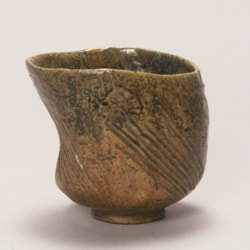
初代長左衛門作
大樋飴釉茶盌 銘:「聖」/Hijiri (Saint)
Tea Bowl, Ohi amber glaze
裏千家十五代家元 鵬雲斎(1923-) 箱
九代大樋長左衛門(1901-1986) 箱
made by Ohi Chozaemon I
Urasenke 15th Hounsai Signed
9th Ohi Chozaemon Signed
初代長左衛門の作品の中でもとりわけ変化に富んだ姿の茶盌である。胴部の一方に弓形の大きな反りをつけ、見込みは深く、一体に薄手に仕上げらている。胴部の三方や高台脇の二方につけたれた櫛目状の荒々しい箆目や全面に薄く施された飴釉、畳み付けの細い小振りな高台など初代長左衛門の特色が随所に見られる。飴釉は一部に青味を帯び、胴の一部には黒色の窯変があらわれている。同じ手びねりで成形であっても楽家とは異なった大樋焼独特の作風が示された一碗ということができる

初代長左衛門作
大樋飴釉茶盌 銘:「聖」/Hijiri (Saint)
Tea Bowl, Ohi amber glaze
裏千家十五代家元 鵬雲斎(1923-) 箱
九代大樋長左衛門(1901-1986) 箱
made by Ohi Chozaemon I
Urasenke 15th Hounsai Signed
9th Ohi Chozaemon Signed
初代長左衛門の作品の中でもとりわけ変化に富んだ姿の茶盌である。胴部の一方に弓形の大きな反りをつけ、見込みは深く、一体に薄手に仕上げらている。胴部の三方や高台脇の二方につけたれた櫛目状の荒々しい箆目や全面に薄く施された飴釉、畳み付けの細い小振りな高台など初代長左衛門の特色が随所に見られる。飴釉は一部に青味を帯び、胴の一部には黒色の窯変があらわれている。同じ手びねりで成形であっても楽家とは異なった大樋焼独特の作風が示された一碗ということができる


The Second Chozaemon was the son of the First Chozaemon. Probably as he was growing up, he was surrounded by the constant interaction between the First Chozaemon and Senso. It is only natural that he followed in his father’s footsteps and continued with the tradition of making Ohiyaki Ware. Because the Second Chozeamon did not sign his work and with only a few signed boxes still in existence, it is difficult to ascertain an accurate account of his true artistic history. Another point that makes it difficult to historically understand exactly what utensils he made, is their striking resemblance to the first Chozaemon’s works. It is felt that he followed in his father’s footsteps not creating his own artistic style, but through continuing his father’s style and mimicking the designs that had already been produced.
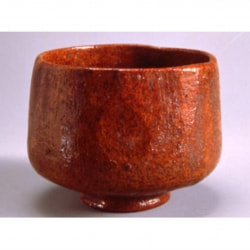
二代長左衛門作
大樋飴釉茶盌 銘:金城霊沢/Kinjyou Reitaku
直斎(武者小路千家四代)
made by Ohi Chozaemon II
Musyakoujisenke 7th Jikisai and 13th Urinsai Signed
軽妙な作振りの茶盌。口辺りから裾にむかって広がり、削り出された高台の畳付は狭く、内に兜巾がみられる。胴には細かく縦箆がまわり、面取風な箆目もみられる。全体に赤味がかかった細い飴釉がかかっている。金沢の地名に由来する「金城霊沢」の銘がつけられている。箱蓋裏には武者小路千家四世直斎が「大樋焼 赤 宗守(花押)」と墨書している

二代長左衛門作
大樋飴釉茶盌 銘:金城霊沢/Kinjyou Reitaku
直斎(武者小路千家四代)
made by Ohi Chozaemon II
Musyakoujisenke 7th Jikisai and 13th Urinsai Signed
軽妙な作振りの茶盌。口辺りから裾にむかって広がり、削り出された高台の畳付は狭く、内に兜巾がみられる。胴には細かく縦箆がまわり、面取風な箆目もみられる。全体に赤味がかかった細い飴釉がかかっている。金沢の地名に由来する「金城霊沢」の銘がつけられている。箱蓋裏には武者小路千家四世直斎が「大樋焼 赤 宗守(花押)」と墨書している



The Third Ohi Chozaemon was the son of the Second Ohi Chozaemon. Both he and his father made tea utensils that were strongly influenced by the First Chozaemon's works. However, unlike his father, the Third Ohi Chozaemon signed his works. He used his father's stamp and interestingly signed his works as the Second Ohi Chozaemon. Although his work was influenced by his grandfather’s style, he expanded his talents by using various designs and employing more technical skills. His specialty was making tea bowls where he incorporated his own spiral design and tube-like styling. He used both a thin and much thicker amber glaze. His water containers display abstract line designs that express a certain calmness and understanding of tea ceremony wares. The Third Chozaemon also introduced the river shrimp motif, which was inspired by the nearby river in proximity to Senso's style.
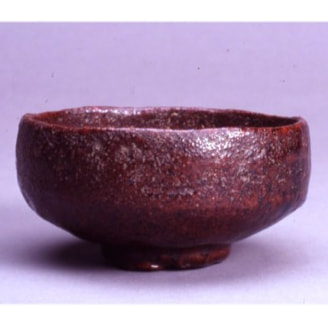
三代長左衛門作
大樋飴釉平茶盌 銘:夕陽
14,0×6,2cmH
made by Ohi Chozaemon III
三代作の平茶盌は、珍しいものである。カリッとした作行で平茶盌としての大きさ、釉調もよく、味わい深い作となっている。加えて在印も珍物中の佳碗としたい。

三代長左衛門作
大樋飴釉平茶盌 銘:夕陽
14,0×6,2cmH
made by Ohi Chozaemon III
三代作の平茶盌は、珍しいものである。カリッとした作行で平茶盌としての大きさ、釉調もよく、味わい深い作となっている。加えて在印も珍物中の佳碗としたい。



It has been recorded that like the First Ohi Chozaemon, the Fourth Chozaemon was also extremely talented and respected as a clay artist. The original spirit of Ohi ware is present throughout the Fourth Chozaemon's works. He was very technically skilled and produced delicate and intricate works paying close attention to each piece’s form and function. He not only used the traditonal Ohi Amber Glaze, but also experimented with various colors of glaze mimicking the First Chozaemon's desire to push the limits of tea ceremony wares. As a deviation from the previous generations, the Fourth also made some tea bowls using the Ohi Black Glaze. In 1882 several of his tea bowls were presented to the 12th Shogun Maeda Narinaga in exchange for an abundance of monetary awards. This relationship between the Fourth Ohi Chozaemon and the 12th Shogun Maeda Narinaga, combined with his extraordinary talents, earned him the tea master's title "Doan," which from 1824 he was then named and referred to.

四代長左衛門作
大樋飴釉梅花紋茶茶盌
made by Ohi Chozaemon Ⅳ
「やや小振りの手取のいい愛らしい茶盌である。東風吹かば唐国までも匂ひけんと天神さんは梅花一枝を持つ、百万石も梅鉢紋。作もよく、画もよし、さすが名工四代長左衛門の作、共に芽出度くこれにて新春を飲んでみたい。」
十代大樋長左衛門(年朗)評

四代長左衛門作
大樋飴釉梅花紋茶茶盌
made by Ohi Chozaemon Ⅳ
「やや小振りの手取のいい愛らしい茶盌である。東風吹かば唐国までも匂ひけんと天神さんは梅花一枝を持つ、百万石も梅鉢紋。作もよく、画もよし、さすが名工四代長左衛門の作、共に芽出度くこれにて新春を飲んでみたい。」
十代大樋長左衛門(年朗)評



During this period of time in history, Kyoto was overwhelmed with political burdens while Kanazawa was flourishing in the arts. The Fifth Ohi Chozaemon was fortunate in this respect and because of the afforded artistic freedom of his day, he produced many original works branching off from the traditional works that were produced by previous generations. He also was very skilled and talented like his father, and even though some of his works were considered quite extreme, he believed thoroughly in producing all kinds of pottery. He made not only tea ceremony wares, but also everyday functional wares such as plates and bowls. The Fifth Chozaemon introduced the crane design that he incorporated into his black tea bowls. It is believed there was a partnership between the 11th Urasenke Grand Tea Master Gengensai (1810 - 1877) and Fifth Chozaemon, since many of his works are accompanied by boxes signed by Gengensai. He also took sand from the Grand Tea Master’s garden and fired tea bowls with the sand. The Grand Tea Master Gengensai also asked the Fifth Ohi Chozaemon to duplicate the turtle-design incense burner made by the First Ohi Chozaemon. This event was recorded by a registered document. The Fifth Ohi Chozaemon's original name was "Kanbei", but most works refer to him as the Fifth Ohi Chozaemon. There are many old books documenting the Fifth Chozaemon’s work but some recorded information, such as his actual birthdate, remain unclear.
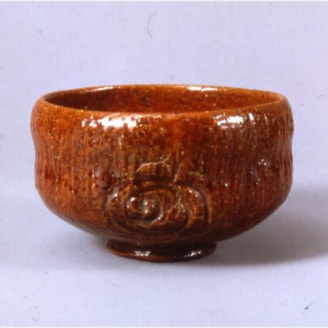
五代長左衛門作
大樋飴釉渦文茶盌 銘:にわたつみ/Niwatatsumi
裏千家十一代家元 玄々斎(1810-1877) 箱
裏千家十五代家元 鵬雲斎(1923-) 箱
Urasenke 15th Hounsai Signed
Urasenke 11th Gengensai Signed
made by Ohi Chozaemon Ⅴ
口を内に抱え、胴を引き締めた茶盌。光沢の強い濃い飴釉が総体にかけられている。胴には大きくしのぎ文風の箆彫りがめぐり、下部にはやや深めに渦文が二つ彫られている。高台内には兜巾がはっきりとみられる。初代長左衛門とも共通した作行きを感じさせる茶盌である。裏千家十一世玄々斎が「にハたつミ」と名付けているが、これは、箆目と渦文を雨水が地上にたまり流れ出す風情を連想したからであろう。

五代長左衛門作
大樋飴釉渦文茶盌 銘:にわたつみ/Niwatatsumi
裏千家十一代家元 玄々斎(1810-1877) 箱
裏千家十五代家元 鵬雲斎(1923-) 箱
Urasenke 15th Hounsai Signed
Urasenke 11th Gengensai Signed
made by Ohi Chozaemon Ⅴ
口を内に抱え、胴を引き締めた茶盌。光沢の強い濃い飴釉が総体にかけられている。胴には大きくしのぎ文風の箆彫りがめぐり、下部にはやや深めに渦文が二つ彫られている。高台内には兜巾がはっきりとみられる。初代長左衛門とも共通した作行きを感じさせる茶盌である。裏千家十一世玄々斎が「にハたつミ」と名付けているが、これは、箆目と渦文を雨水が地上にたまり流れ出す風情を連想したからであろう。



The Sixth Ohi Chozaemon was the son of the Fifth and like his father, he produced not only tea utensils but everyday functional wares as well. His relationship with the Shogun Maeda in Kaga allowed him to prosper monetarily creating many tea utensils using both the Ohi Amber and Black Glazes. He made some works similar to those made by Kenzan, a famous clay artist from the Edo period, and utilized several glaze colors particularly celadon blues from Korea. His original name was Sakutaro and, although he died at the young age of 28, only four months after his father passed away, his original works have been preserved.
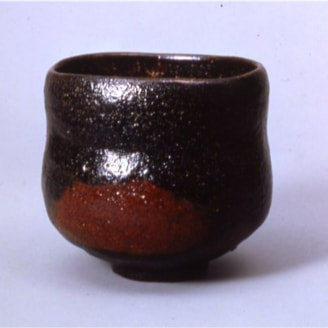
六代長左衛門作
大樋黒釉筒茶盌
9,0×8,8cmH
made by Ohi Chozaemon Ⅵ

六代長左衛門作
大樋黒釉筒茶盌
9,0×8,8cmH
made by Ohi Chozaemon Ⅵ



The Seventh Ohi Chozaemon’s original name was Michitada. He was the brother of the Sixth Chozaemon. Both the Sixth and Fifth Chozaemon passed away in 1856. At the beginning of the Meiji era, Japanese politics began to change dramatically. The Maeda family could not unify the Kaga area. Because of this, the Seventh Ohi Chozaemon was forced to live in poverty. Despite losing the support of the Kaga clans and receiving very few orders for pieces, he continued to produce his own original wares gaining approval from such dignitaries as the 12th Urasenke Grand Tea Master Yumyosai (1852 - 1917) and the 13th Urasenke Grand Tea Master Ennosai (1872 - 1929), who signed his boxes. To the 12th generation Lord Maeda’s wife and daughter of Tokugawa Ienari (1787 - 1837) (wife of 13th generation Lord Maeda), Shin Ryuin and Keitokuin, he presented tea bowls representing his dedication to preserving the tea tradition and his pride in the making of Ohi Ware.
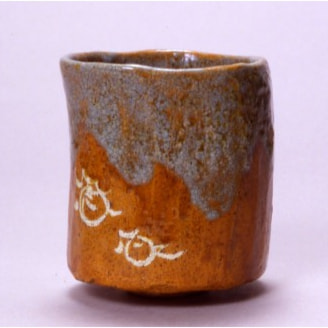
七代長左衛門作
大樋飴釉宝珠文茶盌
9.2cm×9.8cmH
made by Ohi Chozaemon Ⅶ
大樋焼歴代の作品の中で見込みの深い筒茶盌は比較的少ない。この茶盌は胴部の一方に宝珠文を白泥で描いており、きっかりと稜をつけた腰や胴部につけられた太い縦箆などに初代長左衛門造の筒茶盌「聖」に通じる作行が見られる。口部の内外に施された白釉は、青味を帯びて変化ある釉景色をつくっている。高台脇に七代の長方小判形の印が捺されている。

七代長左衛門作
大樋飴釉宝珠文茶盌
9.2cm×9.8cmH
made by Ohi Chozaemon Ⅶ
大樋焼歴代の作品の中で見込みの深い筒茶盌は比較的少ない。この茶盌は胴部の一方に宝珠文を白泥で描いており、きっかりと稜をつけた腰や胴部につけられた太い縦箆などに初代長左衛門造の筒茶盌「聖」に通じる作行が見られる。口部の内外に施された白釉は、青味を帯びて変化ある釉景色をつくっている。高台脇に七代の長方小判形の印が捺されている。



The Japanese economy at this time, along with the introduction of Western art and ideas, affected tea ceremony traditions greatly. The Seventh Ohi Chozaemon’s son made the decision not to follow his father’s path, since the Kaga Clan had cut off support and the family was forced to live in poverty. It would have been a lifelong struggle to keep the Ohi tradition alive and continue making tea utensils that were not profitable or highly appreciated. This way of life did not appeal to the Seventh Chozaemon’s son, thus leaving the position to be filled. Rikichi Nara was the Seventh Ohi Chozaemon’s chief apprentice. He had a thorough knowledge of Ohi work, methods, tradition and history. He became the Eighth Ohi Chozaemon. He was also a tea master. He was given the tea master names of Soshun and Yuigensai. Although the economy remained financially unstable, the Eighth Chozaemon managed to form a relationship with the 486th Shoun Roshi of the temple Daitokuji, which enabled him to produce new works and continue making Ohi ware throughout his entire life. He also received the honor of having many of his boxes signed by Urasenke Grand Tea Master Ennosai (1872 - 1924).
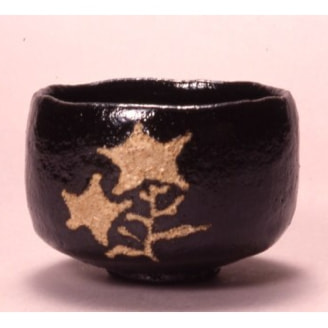
八代長左衛門作
大樋黒釉桔梗文茶盌
10.7cm・8.0cmH
made by Ohi Chozaemon Ⅷ
大樋焼というよりも楽家歴代の黒茶盌に近い姿で、全体にやや大振りである。見込みは広く、底に大きな茶溜まりがもうけられている。胴の一方に桔梗の模様が大きく白抜きであらわされ、その部分には白釉が施されているが、他には光沢のある黒釉がたっぷりとかかっている。高台は低く、おとなしい。胴の一部には、鋏跡が小さく残っている。
十代大樋長左衛門(年朗) 評

八代長左衛門作
大樋黒釉桔梗文茶盌
10.7cm・8.0cmH
made by Ohi Chozaemon Ⅷ
大樋焼というよりも楽家歴代の黒茶盌に近い姿で、全体にやや大振りである。見込みは広く、底に大きな茶溜まりがもうけられている。胴の一方に桔梗の模様が大きく白抜きであらわされ、その部分には白釉が施されているが、他には光沢のある黒釉がたっぷりとかかっている。高台は低く、おとなしい。胴の一部には、鋏跡が小さく残っている。
十代大樋長左衛門(年朗) 評



The Ninth Chozaemon was the son of the Eighth Chozaemon and he continued to produce tea utensils from age sixteen until his death at age eighty-six. At age 26 he received the title of Ninth Ohi Chozaemon following after his father. In the early 1900s, there was little awareness of and appreciation for the tea ceremony and the utensils that accompanied this art form; however, later in the century the cultural preservation of this tradition and renewed interest allowed the artists and makers of tea wares to prosper. The Ninth Ohi Chozaemon’s drive to remain contemporary while still preserving the Ohi tradition led him to display many of his works in public exhibitions, including the Japan Traditional Arts and Crafts in Contemporary Society. His works not only reflect the influence of generations preceding him, but also that of the rapidly changing contemporary environment. In 1960 he received the 4th Kanazawa City Cultural Award. In 1970 he received the gold award of tea and culture from the 14th Urasenke Grand Tea Master, Tantansai (1893 - 1964). In 1978 he was named Todosai by the 15th Urasenke Grand Tea Master, Hounsai. After receiving this honor, he signed his wares using both names Chozaemon Ohi and Todosai. Matsunaga Jian (1875 - 1971), a famous tea master, was one of the Ninth Chozaemon’s greatest patrons. Their relationship led to the creation of many tea bowls that are now displayed in the Ohi Museum Collection. His talents and skills are mostly revealed through tea bowls with the Ohi Black Glaze. It is said that he was a very calm and humble individual throughout his entire life, which also is reflected in his works.

九代長左衛門作
大樋黒釉茶盌 銘:「稀人」
大樋美術館蔵
made by Ohi Chozaemon Ⅸ
加賀の茶陶を代表する大樋焼の窯元は、加賀藩前田家の御茶盌師を務めた家柄である。大樋家の由緒書によると寛文六年(1666)、加賀藩主前田綱紀の茶堂として招請されていた裏千家四世千宗室(仙叟)に従って京都より金沢に移った初代長左衛門が、大樋焼の始まりである。初代は大樋村に窯を築き、仙叟の指導のもとより楽焼の茶盌、水指、香炉、香合などを制作した。四代勘兵衛の代に正式に加賀藩御用を務めたが、明治維新期の七代道忠の時一時期廃窯、明治17年(1884)隣地春日町に再興した。だが、茶陶は片隅に追われ、火鉢、焜炉などを主に制作している。近代茶道界と密接な関係は8代長左衛門の時代に形成。近代における茶盌作りの名手と称されたのが九代大樋長左衛門である。九代大樋長左衛門は明治34年に八代長左衛門(宗春)の次男として生まれた。石川県立工業学校窯業科を卒業後、父のもとで作陶に進み、農商務省工芸展、石川県立工業学校窯業科を卒業後、父のもとで作陶に進み、農商務省工芸展、石川県工芸奨励会などに入選、大正12(1923)には金沢・東山公園麓に工房「芳土庵」を構えた。昭和2年喜寿を迎えた父宗春が引退後、他界それより長左衛門を襲名した。以後、九代長左衛門として初代以来家業とした手捻りによる茶陶作りに精進した。胎土には歴代が使用した大樋村産出の陶土を使い、これに信楽の土が混合されている。大樋焼の特色は初代より手掛けた飴釉(鉄釉を酸化焔焼成したもの)の使用と、全体に砂気の少ない陶土による薄作りの茶盌にある。長左衛門の作風もこの範疇から逸脱することはないが、家芸の飴釉作品では、ねっとりとした釉の肌ざわりと、伸び伸びしたおおらかさのある茶盌を特色とした。 一方、四代の時期以降に大樋家で本格的に焼成されるようになった高火度の黒楽茶盌の胴に垂れ幕のように白い斑が生じた漆黒の釉を幕釉と呼んで珍重するが、九代長左衛門はこの黒幕釉に秀でた陶才を発揮した。九代がこうした黒楽茶盌に独自の境地を深めたのは戦後の昭和30年代のことである。自らも満足がいく作品が生まれたのは60歳代からだと話している。「派手なものは、あっと驚くかもしれないが、無為のものは、あっと驚くかもしれないが、無為のもので世間をあっと言わせるものは難しい。その点、茶盌を作ることも難しい。特に無地ものの大樋焼は派手さがない」「見どころの多い茶盌ならいいとか、世間ではいうが、そういう茶盌は、本当の茶盌じゃないと思う。無為で作って、頭の下がるほどの品位のある茶盌がいいということでしょう」とも語っている。晩年、九代長左衛門は人から自己の作陶信念を聞かれた時、「作っている間は、無の境地になること」という返答をしたというが、この言葉のように九代長左衛門の晩年の茶盌には、口部を内に僅かに抱え込んだ穏やかな作風や、侘びたなかにも抑制された華麗さを持つ作風など独自の境地を示す作域が現れており、そこには枯淡さと共に茶盌を楽しむ情趣の深まりを一層強く感じさせるものがある。

九代長左衛門作
大樋黒釉茶盌 銘:「稀人」
大樋美術館蔵
made by Ohi Chozaemon Ⅸ
加賀の茶陶を代表する大樋焼の窯元は、加賀藩前田家の御茶盌師を務めた家柄である。大樋家の由緒書によると寛文六年(1666)、加賀藩主前田綱紀の茶堂として招請されていた裏千家四世千宗室(仙叟)に従って京都より金沢に移った初代長左衛門が、大樋焼の始まりである。初代は大樋村に窯を築き、仙叟の指導のもとより楽焼の茶盌、水指、香炉、香合などを制作した。四代勘兵衛の代に正式に加賀藩御用を務めたが、明治維新期の七代道忠の時一時期廃窯、明治17年(1884)隣地春日町に再興した。だが、茶陶は片隅に追われ、火鉢、焜炉などを主に制作している。近代茶道界と密接な関係は8代長左衛門の時代に形成。近代における茶盌作りの名手と称されたのが九代大樋長左衛門である。九代大樋長左衛門は明治34年に八代長左衛門(宗春)の次男として生まれた。石川県立工業学校窯業科を卒業後、父のもとで作陶に進み、農商務省工芸展、石川県立工業学校窯業科を卒業後、父のもとで作陶に進み、農商務省工芸展、石川県工芸奨励会などに入選、大正12(1923)には金沢・東山公園麓に工房「芳土庵」を構えた。昭和2年喜寿を迎えた父宗春が引退後、他界それより長左衛門を襲名した。以後、九代長左衛門として初代以来家業とした手捻りによる茶陶作りに精進した。胎土には歴代が使用した大樋村産出の陶土を使い、これに信楽の土が混合されている。大樋焼の特色は初代より手掛けた飴釉(鉄釉を酸化焔焼成したもの)の使用と、全体に砂気の少ない陶土による薄作りの茶盌にある。長左衛門の作風もこの範疇から逸脱することはないが、家芸の飴釉作品では、ねっとりとした釉の肌ざわりと、伸び伸びしたおおらかさのある茶盌を特色とした。 一方、四代の時期以降に大樋家で本格的に焼成されるようになった高火度の黒楽茶盌の胴に垂れ幕のように白い斑が生じた漆黒の釉を幕釉と呼んで珍重するが、九代長左衛門はこの黒幕釉に秀でた陶才を発揮した。九代がこうした黒楽茶盌に独自の境地を深めたのは戦後の昭和30年代のことである。自らも満足がいく作品が生まれたのは60歳代からだと話している。「派手なものは、あっと驚くかもしれないが、無為のものは、あっと驚くかもしれないが、無為のもので世間をあっと言わせるものは難しい。その点、茶盌を作ることも難しい。特に無地ものの大樋焼は派手さがない」「見どころの多い茶盌ならいいとか、世間ではいうが、そういう茶盌は、本当の茶盌じゃないと思う。無為で作って、頭の下がるほどの品位のある茶盌がいいということでしょう」とも語っている。晩年、九代長左衛門は人から自己の作陶信念を聞かれた時、「作っている間は、無の境地になること」という返答をしたというが、この言葉のように九代長左衛門の晩年の茶盌には、口部を内に僅かに抱え込んだ穏やかな作風や、侘びたなかにも抑制された華麗さを持つ作風など独自の境地を示す作域が現れており、そこには枯淡さと共に茶盌を楽しむ情趣の深まりを一層強く感じさせるものがある。
